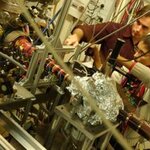Physics

Understanding the origin and behavior of the magnetic fields of planets and stars is the goal of research being carried out by many teams from all over the world. The VKS1 collaboration (CEA2, CNRS3,4, Ecole normale supérieure in Lyon3, Ecole normale supérieure in Paris4) has succeeded in creating in the laboratory a magnetic field in a highly turbulent flow of liquid sodium. Although the extreme conditions specific to astrophysical and geophysical environments cannot all be reproduced in the laboratory, the magnetic field observed shows remarkable similarities with magnetic fields observed…

Superconductivity -- the conduction of electricity with zero resistance -- sometimes can, it seems, become stalled by a form of electronic "gridlock."
A possible explanation why is offered by new research at Cornell University. The research, reported March 5 at the annual meeting of the American Physical Society in Denver, concerns certain copper oxides -- known as cuprates -- that can become high-temperature superconductors, but also can, in a slightly different configuration, become stalled by the "gridlock."
Understanding how and why that transition takes place is a crucial question for…
It's essential to all life, and numerous research papers are published about it every year. Yet there are still secrets to reveal about water, that seemingly simple compound we know as H2O.
Equipped with high-speed computers and the laws of physics, scientists from the University of Delaware and Radboud University in the Netherlands have developed a new method to "flush out" the hidden properties of water--and without the need for painstaking laboratory experiments.
The secrets of water revealed: UD's computer simulation of water molecules is based exclusively on quantum physics laws.…

Researchers have used the world's thinnest material to create the world's smallest transistor – a breakthrough that could spark the development of a new type of super-fast computer chip.
Professor Andre Geim and Dr Kostya Novoselov from The School of Physics and Astronomy at The University of Manchester, reveal details of transistors that are only one atom thick and less than 50 atoms wide, in the March issue of Nature Materials.
They believe this innovation will allow the rapid miniaturisation of electronics to continue when the current silicon-based technology runs out of steam.
In recent…

Professor Sam Braunstein, of the University of York's Department of Computer Science, and Dr Arun Pati, of the Institute of Physics, Sainik School, Bhubaneswar, India, have established that quantum information cannot be 'hidden' in conventional ways, or in Braunstein's words, "quantum information can run but it can't hide."
This result gives a surprising new twist to one of the great mysteries about black holes.
Conventional (classical) information can vanish in two ways, either by moving to another place (e.g. across the internet), or by "hiding", such as in a coded message. The famous…

Using the highest magnetic fields in the world, an international team of researchers has observed the quantum Hall effect – a much studied phenomenon of the quantum world – at room temperature.
The quantum Hall effect was previously believed to only be observable at temperatures close to absolute zero (equal to minus 459 degrees). But when scientists at the National High Magnetic Field Laboratory in the U.S. and at the High Field Magnet Laboratory in the Netherlands put a recently developed new form of carbon called graphene in very high magnetic fields, scientists were surprised by what…

Physicists at JILA are using ultrashort pulses of laser light to reveal precisely why some electrons, like ballet dancers, hold their spin positions better than others—work that may help improve spintronic devices, which exploit the magnetism or "spin" of electrons in addition to or instead of their charge. One thing spinning electrons like, it turns out, is some disorder.
JILA is a joint venture of the National Institute of Standards and Technology (NIST) and the University of Colorado at Boulder.
JILA research shows that electrons tend to hold consistent "spins" longer in low-energy,…

How do you get information from a preparation that is transparent? How can you still see a three-dimensional image through a microscope? Dutch researcher Rajesh S. Pillai investigated a new way of illuminating preparations under the microscope. For example, he could investigate the microstructure of food, which is important for the taste and shelf-life. Furthermore, this technique is highly promising for research into how fat is stored in the human body.
A blow with the hammer
Images can only be made under the microscope if the preparation is illuminated. Sometimes using a single lamp is not…

Fermions tend to avoid each other and cannot "travel" in close proximity. Demonstrated by a team at the Institut d'optique (CNRS/Université Paris 11, Orsay-Palaiseau), this result is described in detail in the January 25, 2007 issue of Nature. It marks a major advance in our understanding of phenomena at a quantum scale.
For many years, the theory of quantum mechanics stipulated that certain particles, the fermions(1), were incapable of "travelling" in close proximity. For example, in a jet of identical particles, the theory supposed that the distance between them was always greater than a…

Physicists at JILA have demonstrated that the warmer a surface is, the stronger its subtle ability to attract nearby atoms, a finding that could affect the design of devices that rely on small-scale interactions, such as atom chips, nanomachines, and microelectromechanical systems (MEMS).
JILA scientists measured how temperature affects the Casimir-Polder force using an apparatus that holds four small squares of glass inside a vacuum chamber. A cloud of ultracold atoms in a Bose-Einstein Condensate (BEC) was held a few micrometers below one piece of glass, and the force was calculated based…